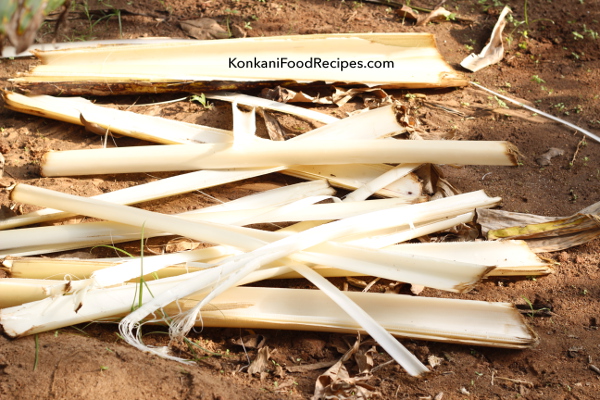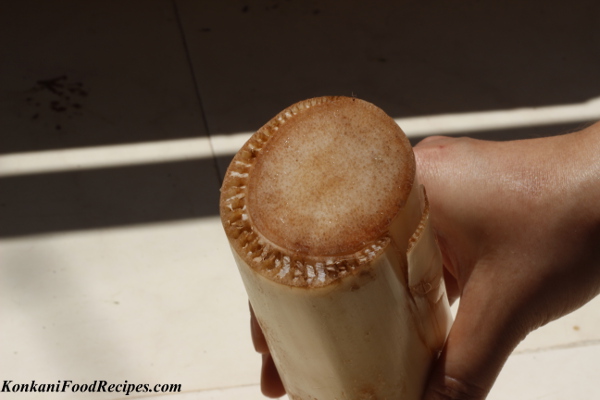Horse Gram, Tender Plantain Stem Curry With Garlic Seasoning (Kulta Gabbe Koddel)

Kulta gabbe kodel, also called gabbe randayi in Konkani is a nice combination of plantain stem (called as gabbo in Konkani) & horse gram (called as kulitu in Konkani) in a delicious coconut curry with a heavenly smell and flavour of garlic seasoning. Soft well cooked horse gram is paired with crunchy plantain stem in this delicious curry. (They have a nice bite to them even on cooking.) This curry makes a simple meal heavenly and tasty when it is had with steaming hot rice. The garlic seasoning fills your house and your whole neighbourhood with its appetizing aroma.
Once a banana bunch is fully grown & mature, it is chopped off from the plant. The plantain plant which bore the plantain bunch isn't of any use. So, it is chopped off from the ground level. The trunk is then cut, the hard, fibrous, outer layers are removed and the inner tube shaped tender stem, which can't be peeled anymore is used in cooking (look for pictures below). It is edible, rich is fibre and is extremely nutritious. In Konkani, it is called as gabbo. This stem is then diced into cubes and is used to make this curry. Yes, vegetarians do eat any & every edible part of any & every plant seen on this planet. :-) Plantain stem is used as a complementary vegetable in this curry and is used to prepare chutneys, stir fry's in Konkani cuisine.
One gets quite a large quantity of banana stem which may be too much to cook at one go for 2 people. So, use the upper section of banana stem which is quite tender. Banana stem has a poor shelf life and has to be consumed in a couple of days.
Banana stem is high in fibre & like the fruit is high in potassium & Vitamin B6. It maintains fluid balance in our body & has cooling properties. So, it's good to eat banana stem once a week, in summer. This explains why banana stem is always paired with horse gram in coconut curries of Konkani cuisine, horse gram counteracts the cooling property banana stem has on our body. I admire the way our cuisines have been put together. There's a reason why we eat, what we eat, what time of the year, how we eat them and with what. :) It's simply amazing!
Plantain stem has curative powers especially for kidney related ailments and urinary disorders. It is good for kidney stones. People who suffer from kidney stones should boil banana stem pieces in water every day and drink on an empty stomach every morning. Or juice the banana stem, add a pinch of salt & have a glassful every day. It also acts as roughage when is used in curries and gravies due to its high fibre content. Thus, it also helps in bowel movement and helps cleanse your system as it is roughage that can't be digested. They even say it removes any hair in our intestines. Don't know how far that's true. :-)
Tips on using the right banana stem to make this curry:
1. Once the plantain bunch matures completely, after you chop it off, chop off the banana stem. Leave out the plantain stem 3 feet above the ground to avoid chewy, hard stem.
Unless your banana bunch is completely mature, you'll not find a fibrous inner core to eat in the banana stem.
2. Use tender banana stems as much as possible in curries & in cooking. They otherwise tend to be very hard, chewy and fibrous even on cooking. You'll know this as you cut into the inner core of banana stem. The amount of pressure you need to apply while chopping it.
3. The thickness of the inner core of plantain stem you get after peeling the outer layers depends on the variety of the banana plant.
4. The long core that you see in the picture below is the tender most core that you can get from one plantain, leaving out the bottom 3 feet and the top most tender part of plantain stem.
5. As you eat cooked banana stem, on chewing you'll find a fibrous residue left over in the end. Throw that away.
6. Banana stem are crunchy even after cooking and if you find it very fibrous & hard, then you have used an overgrown stem part, not the tender one.
7. If at all you remove small banana plants for keeping the babies under control then use their stem, they make the best dish. Their stem would be tender.
Ingredients to make this curry:
3 cups of cubed tender banana stem
1/2 cup horse gram
3/4th cup grated coconut
6 dried red chillies
1 lemon sized tamarind
12-14 garlic cloves
3 tablespoons of oil
Salt to taste
Serves: 2-3
Preparation Time: 45 minutes
Preparation Method:
1. Cook horse gram using enough water (1.5 cups) in a pressure cooker until it's completely cooked and soft. Will require 6-7 whistles, soak them to reduce cooking time.
2. Meanwhile prep the tender banana stem.
Prepping tender banana stem:
3. The plantain stem will have many thick and thin outer layers, peel them until you get a hard inner core that can't be peeled anymore. Use a sharp knife or your fingers to do this job for you. They may stain your clothes if they come in touch with the banana stem juices, so take care not to.
Peel until a white, tube light like section remains. The upper section of this banana stem is the most tender one.
You get a long inner core like the one below from one plantain stem.
4. Chop banana stem core into cubes and put them into a vessel containing water, as they oxidise and turn brown quickly when exposed to air. Using your fingers, remove off the fiber that comes out with every cut into the banana stem.
5. If the plantain stem you are using, has a lot of sticky glue, then add chopped pieces of plantain stem into water containing turmeric or mix the pieces well with a little buttermilk to remove off the glue.
6. Keep the banana stem cubes dipped in water for 10-15 mins so that it gives away any bitterness it has.
7. Then pressure cook the pieces with salt for 1-3 whistles. You will not overcook them. You can even cook them directly on flame for 10-15 minutes. They don't take long to cook and they don't get soft on cooking. They remain crunchy even after cooking. I personally love this crunch they have in the curry.
Preparing the masala:
8. Fry dried red chillies with few drops of oil for 2-3 minutes until you get a nice aroma. Put off the flame and set it aside to cool.
9. Once chillies cool down, grind them along with grated coconut, tamarind, salt into a very smooth paste, using as much water as required. Keep the ground masala aside.
10. Transfer cooked horse gram and plantain into a cooking vessel along with their stock (water used to cook them).
11. Then add ground masala to it and bring the curry to boil. Check and adjust salt.
12. Add water if required to bring the curry to semi-thick consistency. We do not want it too thick nor too watery.
13. Once the curry comes to a boil, simmer it for few minutes until the rawness of the ground masala goes off.
14. Remove the curry from heat and season it with garlic.
15. Garlic seasoning: Heat oil in a tempering pan, add in slightly pounded garlic and fry them until they turn golden brown. Add this tempering to the curry and mix well.
16. Serve steaming hot curry with a bowl of steaming hot rice.
Find more Konkani cuisine curry recipes here.
Tags: currys, kodel, horse gram, gabbo, plantain/banana stem recipe, lunch, dinner, randayi, Konkani recipe, Konkani dish, Konkani cuisine, Udupi cuisine, Mangalore food, Konkani food, gabbe randayi, gabbe kodel, vegetarian, vegan.







Tweet